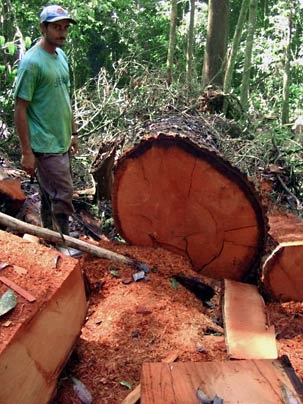In the World is a new column that explores the ways people from MIT are using technology--from the appropriately simple to the cutting edge--to help meet the needs of local people in places around the planet. If you know of a good example and would like the News Office to write about it, please e-mail dlc1@mit.edu.
Villagers in tiny communities including Guayabo, Sawacito and Mahor, in the rainforest of northeastern Honduras, used to take part in the rampant illegal trade in mahogany, but recently they have formed a cooperative and learned to harvest the prized wood in sustainable ways. Now, they mostly use trees that have fallen naturally or harvest them in a sustainable way from around the fringes of the nearby Rio Platano Biosphere Reserve, and remove planks from the forest, first on their backs, then on muleback to avoid the disruption caused by heavy machinery.
They are working on getting certification for their wood from the Rainforest Alliance, and they have one big customer, the U.S. guitar company Gibson. Thanks to their new way of doing business, dealing directly with the customer, they are earning 4 times more per board-foot of lumber than they were before.
But they still have a problem: Gibson doesn't need enough of the wood to sustain the cooperative. In order to continue their sustainable logging, they need new customers. And that's where MIT Sloan School master's student Craig Doescher comes in.
Doescher has joined a group of U.S. business and financial partners to help launch a new business based in Honduras, called Tegu Toyworks, that will manufacture wooden toys for export to stores in the United States and Europe. They hope to employ local Honduran craftspeople at the factory and to use the output of the forest cooperative as their primary material, providing them with a major new customer.
"They're trying to preserve the rainforest and use it in a sustainable way, but there isn't a sufficient market for it yet," Doescher says. "We're trying to fill that void." And because the toys don't require the use of familiar woods like mahogany, they will be able to use--and help build demand for--lesser-known species, such as huesito, San Juan areno and selillon wood.
The toys will be high-end, innovative creations, whose designs are being finalized now. While many Honduran craftspeople already make hand-carved wooden pieces, these have tended to be relatively simple pieces designed for the local tourist market. These toys, designed for more lucrative markets, will enable the company to pay premium wages to their employees.
Doescher, who had prior experience working in a manufacturing plant, came to MIT specifically to develop his interest in combining entrepreneurial skills with work in the developing world. He joined a team that had already been developing the toy-company plan, brothers Chris and Will Haughey and their partner John Herbold, all of whom have experience in consulting or finance (Chris left a job with Boston Consulting Group to work full-time for the new company). Chris Haughey also had experience as a Christian missionary in Honduras, where he assisted a home to get boys off the street of the capital city, Tegucigalpa.
"We see this great opportunity and potential," says Doescher, especially at a time when inexpensive, imported toys have been the subject of massive, widely reported recalls for problems including lead paint.
"The U.S. market is moving toward more-natural, more-sustainable products," he says. "That helps to build our business case."
Tegu Toyworks hopes to have its first factory in operation, in the outskirts of Tegucigalpa, by early next year--although if things go really well, they'd like to move faster and have some products ready for this year's holiday season. "We're working on some pretty innovative designs," Doescher says. "Our goal is not to have a me-too kind of product."
One challenge in finalizing plans for the factory is to determine "the right mix of automation versus hand labor," Chris Haughey says. Using his own experience in manufacturing, Doescher hopes to introduce some of the efficiencies of modern, automated factory systems to the process, including computer numerical control systems for initial shaping of pieces, while also making use of local skills for such tasks as finish-sanding by hand. Initially, the labor will be local Hondurans, but as quickly as possible the team hopes to train locals to take over much of the factory's management as well. The U.S. team would continue to use their expertise in the areas of design, advertising and distribution.
In the longer term, they hope the business will serve "as an incubator for Honduran entrepreneurs, as people gain a sense of what they can do," says Chris Haughey. Doescher adds that "one of the most important things will be to find the right management down there. Most likely, these people will end up with some ownership" of the company.
Doescher, who is entering the Tegu Toyworks project in MIT's 100K Business Plan Competition, visited Honduras this January thanks to a small grant from the Legatum Center to help lay the groundwork for the project. He hopes that over time the company can "migrate as much of the value added as possible to Honduras. If we can ultimately transition the marketing and design to Honduras, that would be a home run for us."
For more information, e-mail chris@tegutoys.com or craig@tegutoys.com.
A version of this article appeared in MIT Tech Talk on February 13, 2008 (download PDF).






